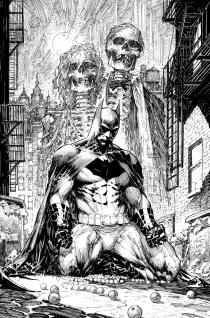Batman: Black and White" #1, a revival of the anthology title from the 1990s, features five new Batman short stories by Chip Kidd, Neal Adams, Maris Wicks, John Arcudi, Howard Mackie, Michael Cho, Joe Quinones, Sean Murphy and Chris Samnee. It's a pleasure to see that the five stories have strong creative rosters. All the artists have a confident, distinctive style. The atmosphere is unexpectedly light and funny all around, with no hint of noir.
First up is "Don't Know Where, Don't Know When" by Chip Kidd and Michael Cho. It's a cheery dad-and-son-type Batman and Robin story, with a deliberately dated feel for both style and content, including the title, which is a reference to lyrics from a WWII-era pop song, "We'll Meet Again." The lost-and-found mechanics of the plot are cute but superficial. It's reminiscent of Paul Dini or Bruce Timm's cartoons, but it doesn't feel as polished. Kidd does write in a fun surprise cameo by another caped crusader, who feels less suited to a no-color world than Batman. Cho's style is deliberately retro, with huge, blocky onomatopoeia written sound effects like "KA-THWACK." While Cho is a talented illustrator, his work here feels a little cluttered and stiff for the movement-heavy panel to panel transitions.
The second story, "Batman Zombie" by Neal Adams is the only story without black inks. It's a great choice that preserves all the detail of Adams' confident fine pencil work. The beginning pages are little crowded with word balloons at first, but loosens up as the story goes on. It's a pleasure how Adams lavishes attention on the faces of ordinary nameless citizens that Batman meets. The title isn't kidding around; the Dark Knight looks pretty gross as a zombie, but the effect is humorous instead of gory. However, mid-story, the tone shifts from oddball comedy to political polemic. Adams writes a Batman story written to diminish Batman's heroism in favor of what an ordinary citizen can do. Unfortunately, Adams over-focuses on his agenda, resulting in stilted and forced-sounding dialogue, and the "just a dream" ending can be seen coming miles away. While Adams' art is impressive, "Batman Zombie" is an ill-suited vehicle for political criticism of three-strikes habitual offender statutes.
The third story, "Justice Is Served," by Maris Wicks and Joe Quinones is the only one in "Batman: Black and White" where Batman is not the protagonist. Instead, Wicks and Quinones deliver a delightful Harley and Ivy story, full of lighthearted physical humor centering on the unfortunate swelling of Harley's dogs. It's a pleasure to read Wicks and Quinones' take on Harley in her classic, pre-New 52 costume, looking very sassy as she robs a burger joint of only some burgers for herself and "Mistah Jay." Quinones' art excels at humor and facial expressions, particularly in the panel in which Harley recaps events for Ivy chibi-style. Wicks' story and Quinones' art feel like a perfect match, resulting in a story that is the strongest of the bunch in making the best use of the limited page count.
"Driven" by John Arcudi and Sean Murphy is a Batman and Alfred story that has the structure of an extended joke. The joke itself is smile-worthy but old hat. Arcudi's dialogue plays up Alfred's role as an indulgent butler well, much in the manner of Jeeves and Wooster. Batman himself feels younger and uncharacteristically cheerful. Mostly, "Driven" is written to allow for Murphy to showcase his considerable flair in drawing chase scenes and plenty of gearhead Batmobile detail.
"Head Games" by Howard Mackie and Chris Samnee is another Batman and Alfred story. Like "Don't Know Where, Don't Know When," it also has a retro style and feel, particularly in the sentimental ending. Despite this feeling of familiarity, it has the most suspense and emotional depth of all the stories, mostly due Samnee's visual pacing and facial expressions and Mackie's attention to the villain's feelings.
"Batman: Black and White" #1 has stronger visuals than scripting overall, but Maris Wicks' comics writing debut and the strength of the artwork make this revived anthology worth a look.

